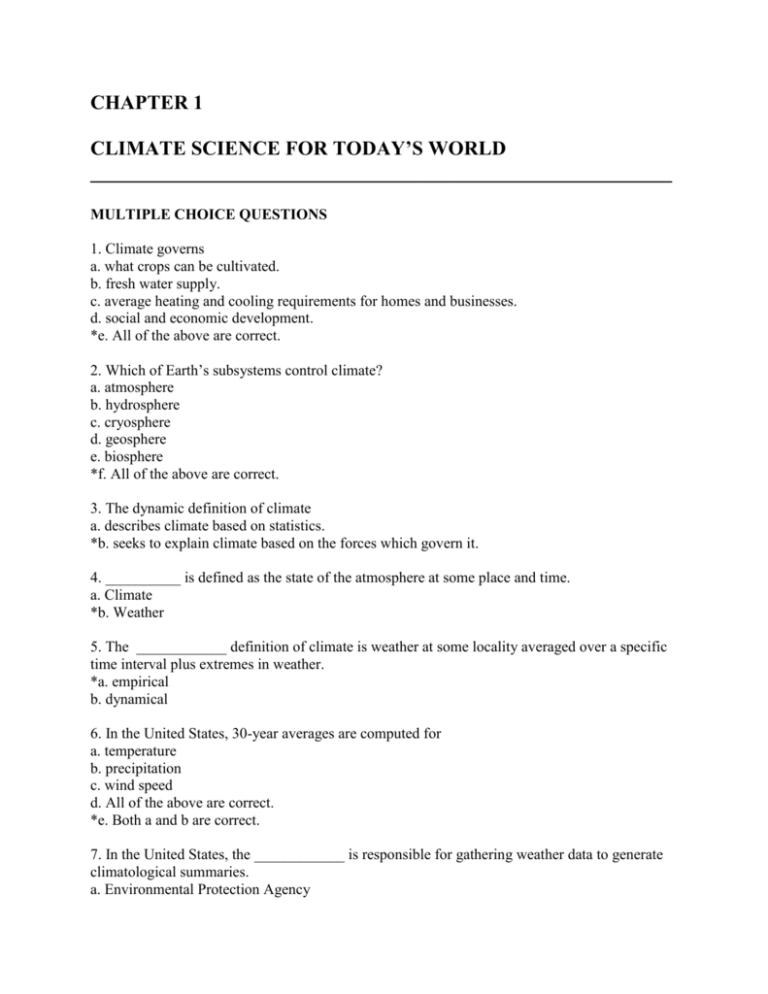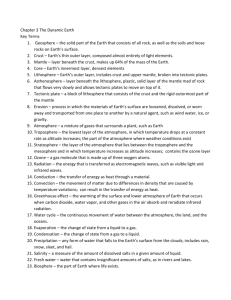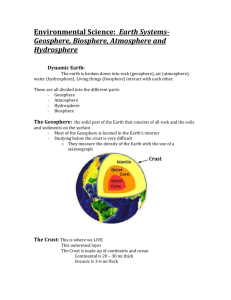Ch01TBAns
advertisement

CHAPTER 1 CLIMATE SCIENCE FOR TODAY’S WORLD __________________________________________________________ MULTIPLE CHOICE QUESTIONS 1. Climate governs a. what crops can be cultivated. b. fresh water supply. c. average heating and cooling requirements for homes and businesses. d. social and economic development. *e. All of the above are correct. 2. Which of Earth’s subsystems control climate? a. atmosphere b. hydrosphere c. cryosphere d. geosphere e. biosphere *f. All of the above are correct. 3. The dynamic definition of climate a. describes climate based on statistics. *b. seeks to explain climate based on the forces which govern it. 4. __________ is defined as the state of the atmosphere at some place and time. a. Climate *b. Weather 5. The ____________ definition of climate is weather at some locality averaged over a specific time interval plus extremes in weather. *a. empirical b. dynamical 6. In the United States, 30-year averages are computed for a. temperature b. precipitation c. wind speed d. All of the above are correct. *e. Both a and b are correct. 7. In the United States, the ____________ is responsible for gathering weather data to generate climatological summaries. a. Environmental Protection Agency b. National Aeronautics and Space Administration *c. National Weather Service d. National Institute of Standards and Technology 8. A boundary condition (or forcing) of the planetary system is the a. incoming solar radiation. b. albedo of Earth’s surface. *c. Both of the above are correct. d. None of the above is correct. 9. The ____________ definition of climate combines boundary conditions and associated typical weather patterns that vary seasonally. a. empirical *b. dynamical 10. For which climatic element is the mean value about the same as the median (middle) value? *a. temperature b. precipitation c. Both of the above are correct. 11. The ___________ feeds weather data to NWS Forecast Offices. a. Automated Surface Observing System b. NWS Cooperative Observer Network *c. Both of the above are correct. d. None of the above is correct. 12. The nation’s most exploited watershed is that of the ___________ River. a. Ohio b. Susquehanna *c. Colorado d. Rio Grande 13. A(n) ___________ consists of communities of plants and animals that interact with one another. a. mesosphere b. lithosphere *c. ecosystem 14. Boundaries between ecosystems, known as ecotones, are particularly ___________ climate change. *a. vulnerable to b. unaffected by 15. The components of a system, such as the Earth system, interact in a(n) ___________ manner according to the laws of physics, chemistry, and biology. a. random *b. orderly 16. Compared to the diameter of the Earth, the atmosphere is a relatively ___________ envelope of gases and tiny suspended particles. *a. thin b. thick 17. Which layer of the atmosphere contains 99% of its water? *a. troposphere b. stratosphere c. mesosphere d. thermosphere 18. Which gases have the greatest concentration in the atmosphere? a. carbon dioxide and water vapor *b. nitrogen and oxygen c. argon and methane 19. Aerosols a. are large solid and liquid particles suspended in the atmosphere. b. mostly occur in the upper parts of the atmosphere. *c. function as nuclei that promote cloud formation. d. All of the above are correct. 20. The significance of an atmospheric gas is _________ related to its concentration. a. always *b. not necessarily 21. On an average annual basis, the _________ experience net radiational heating and the _________ experience net radiational cooling. *a. tropics…..polar latitudes b. polar latitudes…..tropics 22. _________ is the only naturally occurring substance that co-exists in all three phases at the normal range of temperature and pressure observed near Earth’s surface. a. Carbon dioxide b. Methane *c. Water d. Ozone e. Nitrogen 23. What is the largest reservoir of water in the hydrosphere? a. glacial ice *b. ocean salt water c. rivers and lakes d. groundwater 24. Ocean surface currents are mostly a. density-driven. *b. wind-driven. 25. Water density increases with *a. decreasing temperature and increasing salinity. b. increasing temperature and decreasing salinity. 26. The cryosphere is the _________ portion of the hydrosphere. *a. solid b. liquid c. gaseous 27. What force drives the flow of a glacier? a. pressure gradient force b. friction *c. gravity 28. During summer, most of the sea ice __________ melts. *a. around Antarctica b. in the Arctic Ocean 29. The geosphere consists of a. rocks. b. minerals. c. soil. d. sediments. *e. All of the above are correct. 30. The Earth’s four spherical shells, from the Earth’s surface inward, are a. outer core, inner core, crust, mantle. b. mantle, inner core, outer core, crust. *c. crust, mantle, outer core, inner core. 31. The lithosphere consists of *a. the crust and uppermost portion of the mantle. b. the crust alone. c. the mantle alone. d. the mantle and uppermost portion of the outer core. e. the inner core alone. 32. __________ is the physical disintegration, chemical decomposition, or solution of exposed rock whereas __________ refers to the removal and transport of sediments. a. Erosion…..weathering *b. Weathering…..erosion 33. __________ explains discoveries such as glacial sediments in the Sahara and fossil coral reefs in northern Wisconsin. *a. Plate tectonics b. Photosynthesis c. Cellular respiration 34. All living plants and animals compose the *a. biosphere. b. lithosphere. c. hydrosphere. 35. Photosynthesis takes up __________ from the atmosphere, and releases __________. *a. carbon dioxide…..oxygen b. oxygen…..carbon dioxide 36. The sugars produced by __________ are essential for __________. a. cellular respiration…..photosynthesis *b. photosynthesis…..cellular respiration 37. __________ form the base of most ecosystems. a. Heterotrophs b. Carnivores c. Consumers *d. Producers 38. At most, about __________ of the energy available at one trophic level of a food chain is transferred to the next level. *a. 10% b. 25% c. 50% d. 75% 39. An example of a biogeochemical cycle is the a. water cycle. b. carbon cycle. c. oxygen cycle. d. nitrogen cycle. *e. All of the above are correct. 40. Earth is an open (or flow-through) system for __________, but essentially a closed system for __________. *a. energy…..matter b. matter…..energy 41. In biogeochemical cycles, matter __________ created or destroyed. a. is always b. is only sometimes *c. cannot be 42. __________ is the amount of material transferred from one reservoir to another within a specified period of time. *a. Cycling rate b. Residence time 43. __________ is the average length of time for a substance in a reservoir to be completely replaced. a. Cycling rate *b. Residence time 44. The residence time of a water molecule in the atmosphere is about __________ day(s). a. 1 b. 5 *c. 10 d. 50 45. What process is a sink for carbon dioxide in the ocean? a. photosynthesis b. cellular respiration c. the production of calcium carbonate protective shells by marine organisms d. All of the above are correct. *e. Only a and c are correct. 46. Fossil fuels include a. coal. b. oil. c. natural gas. *d. All of the above are correct. e. None of the above is correct. 47. During combustion, carbon from fossil fuels combines with _________ from the atmosphere to form carbon dioxide. a. nitrogen *b. oxygen c. water vapor d. argon 48. A reservoir in the global water cycle: a. hydrosphere b. atmosphere c. geosphere d. biosphere *e. All of the above are correct. 49. Climate can be explained primarily in terms of the complex redistribution of _________ by Earth’s coupled atmosphere/ocean system. a. heat energy b. matter *c. Both of the above are correct. d. None of the above is correct. 50. Rapid climate changes impact which of the following? a. biological systems b. water resources c. food production d. energy demand *e. All of the above are correct.









